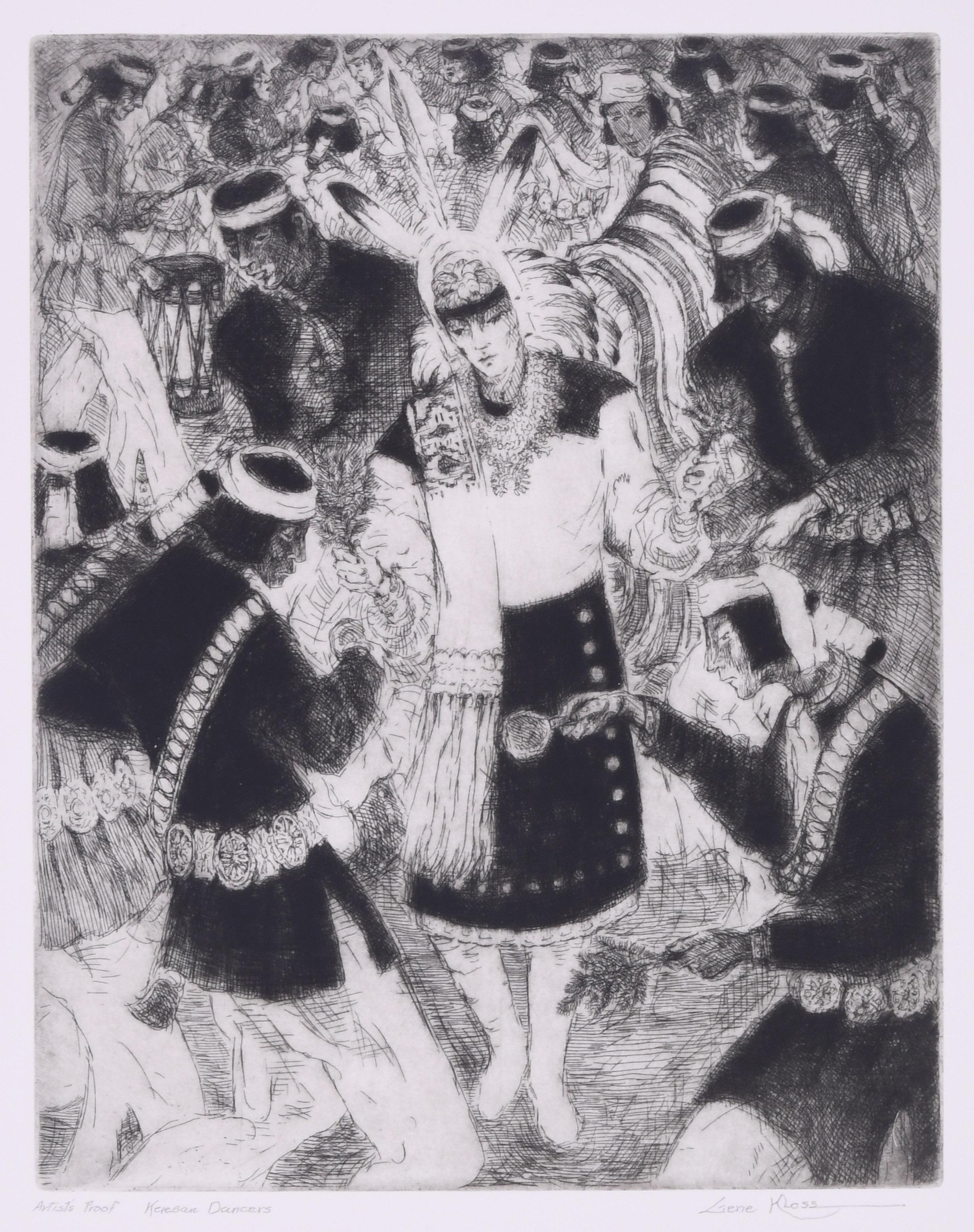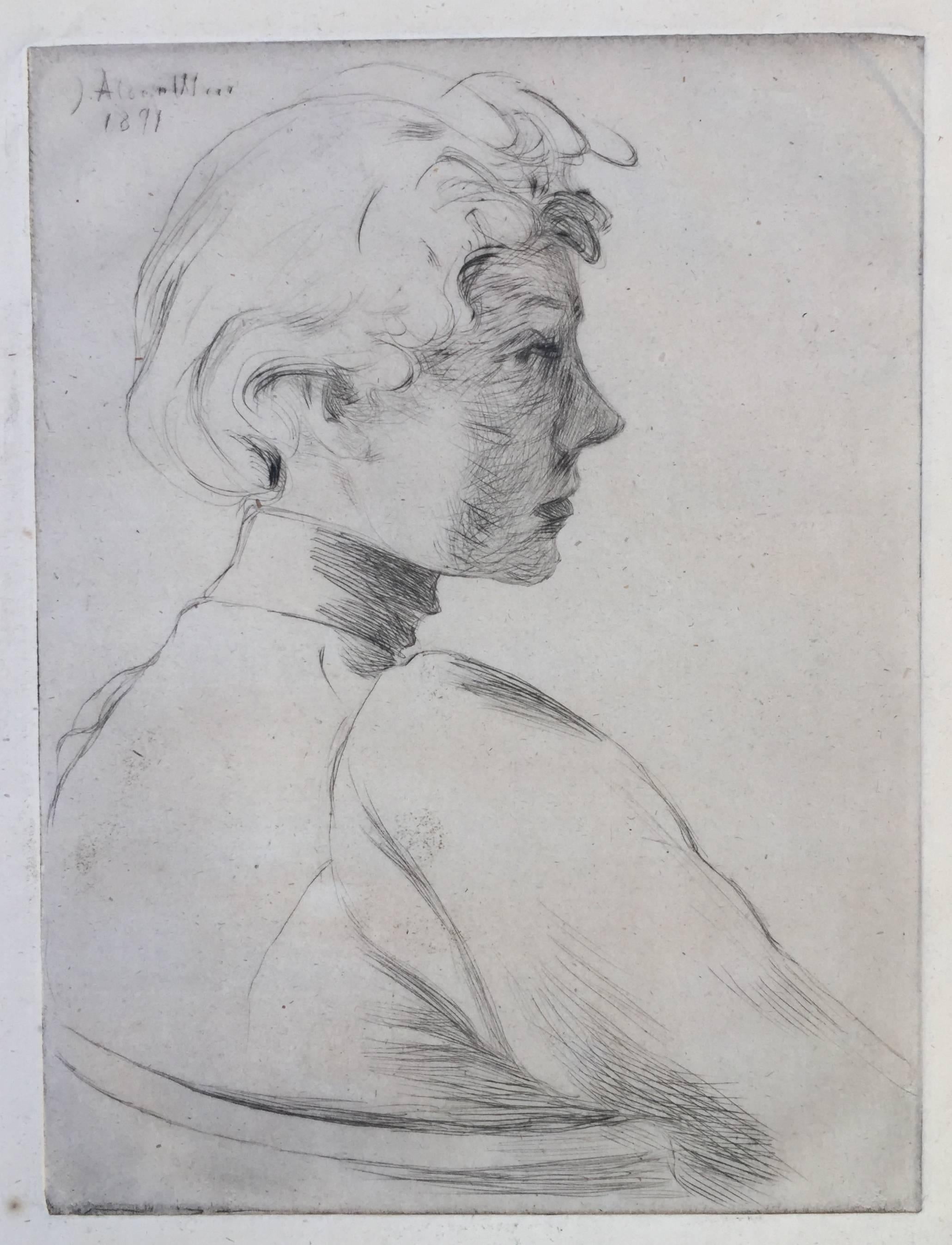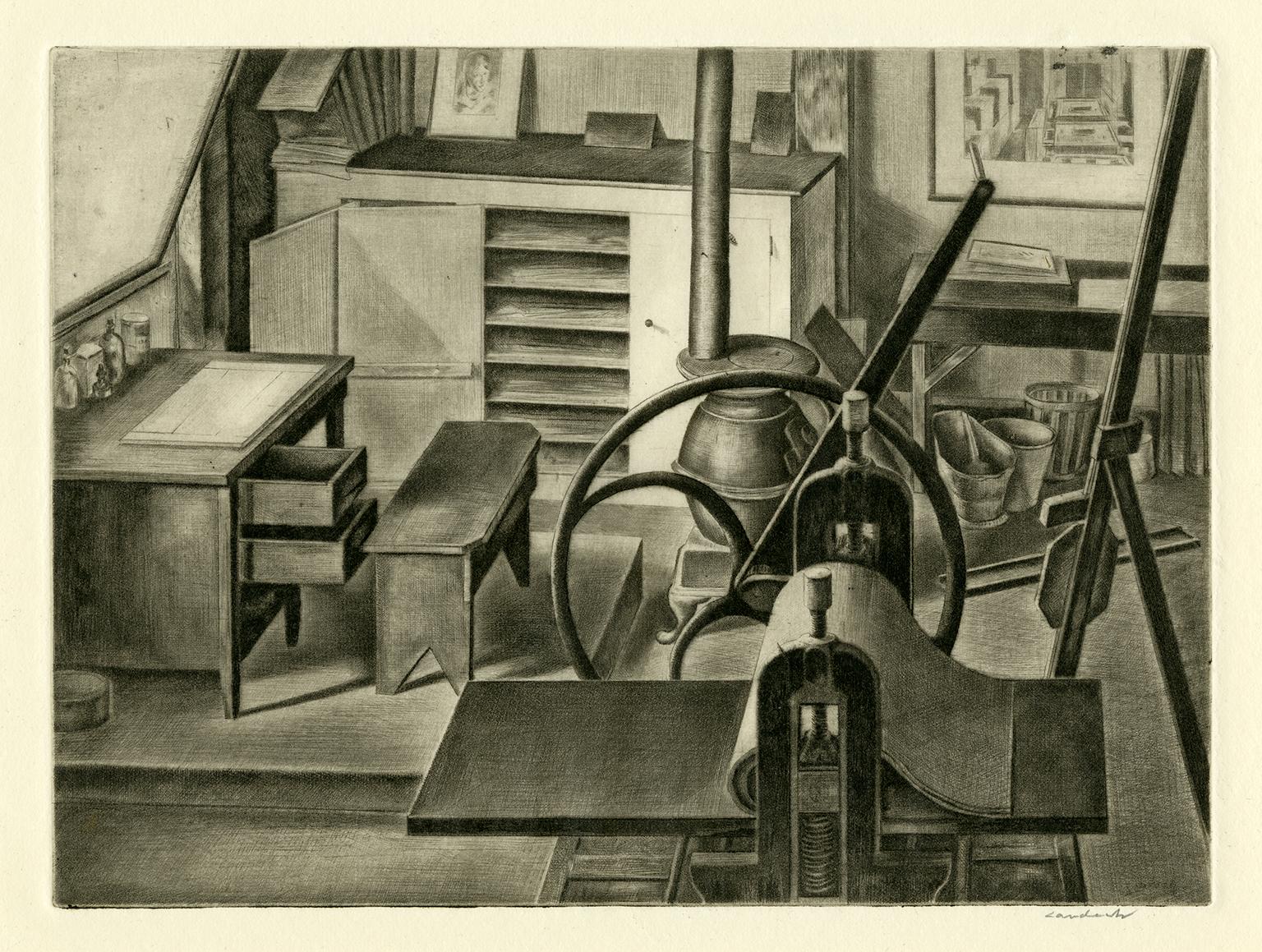George Caleb BinghamThe County Election1854
1854
About the Item
- Creator:George Caleb Bingham (1811 - 1879)
- Creation Year:1854
- Dimensions:Height: 30 in (76.2 cm)Width: 37 in (93.98 cm)Depth: 1 in (2.54 cm)
- Medium:
- Movement & Style:
- Period:
- Condition:
- Gallery Location:Missouri, MO
- Reference Number:1stDibs: LU74735417742
George Caleb Bingham
George Caleb Bingham was born in Augusta County, Virginia in the Shenandoah River Valley on March 20, 1811. In 1819, as an eight-year-old, he moved to Boone's Lick, Missouri with his parents and grandfather who had been farmers and millers in the Shenandoah Valley near Rockingham, Virginia. As a child, he took every opportunity to escape supervision to travel to the river and watch the marine activity. His father died in 1823 when he was 12 years old. His mother had encouraged his artistic talent, but art lessons were not easily obtainable. To earn money, he apprenticed to a cabinet maker but became determined to become an artist. By 1835, he had a modest reputation as a frontier painter and successfully charged twenty dollars per portrait in St. Louis. “His portraits had become standard decorations in prosperous Missouri homes”, said Samuels about Bingham. In 1836, he moved to Natchez, Mississippi and there he had the same kind of career and was able to charge forty dollars per portrait. He remained largely self-taught until 1837 when he started using the proceeds from his portraiture and studied several months at the Pennsylvania Academy of the Fine Arts. Bingham credited Chester Harding as being the earliest and one of the most lasting influences on his work. Harding, a leading portraitist when Bingham was a young man, had a studio in Franklin, near Bingham's home town. In 1822, when Bingham was 10 years old, he watched Harding finish a portrait of Daniel Boone. Bingham recalled that watching Harding with the Boone portrait was a lasting inspiration and that it was the first time he had ever seen a painting in progress. Harding suggested to Bingham that he begin doing portraiture by finding subjects in the river men, which, of course, opened the subject matter that established fame and financial success for Bingham. He later painted two portraits of Boone. Bingham's portraits of Boone are not located, but one of them, a wood signboard for a hotel in Boonville circa 1828–30, showed a likeness of Boone in a buckskin dress with his gun and inscription Daniel Boone / Liberty. From 1840–44, Bingham was based in Washington DC where he painted portraits of prominent citizens, but he failed to achieve much recognition until he returned to Missouri in 1844 and began painting river genre works from a studio in St. Louis. Among the first notable paintings of his signature subject was Fur Traders Descending the Missouri in 1845. He later said that he learned much of his atmospheric style and classically balanced composition by copying paintings in collections in St. Louis and Philadelphia and that among his most admired painters were Thomas Cole, John Vanderlyn and William Sidney Mount. George Caleb Bingham became known for classically rendered western genre, especially Missouri and Mississippi River scenes of boatmen bringing cargo to the American West and politicians seeking to influence frontier life. One of his most famous river genre paintings was The Jolly Flatboatmen in 1846. The first version of this painting is in the Manoogian Collection at the National Gallery of Art. This work gained fame when it was exhibited in New York at the American Art Union, whose organizers made an engraving of 10,000 copies and distributed it to all of their members. Paintings such as Country Politician in 1849, County Election in 1852 and Stump Speaking in 1854 reflected Bingham's political interests. Between 1856–59, Bingham traveled back and forth to Düsseldorf, Germany, where he studied the work of genre painters. Some critics think these influences were negative on his work because, during that period, he abandoned the luminist style that had brought him so much public affirmation. Bingham was creative artistically and at the same time, he was running for state office. He was a member of the Whig party, founded in 1834 as a coalition opposed to Andrew Jackson, who was the US President. Bingham's close friend and influential Missouri Whig, James Sidney Rollins, drew him into politics. Bingham gave speeches for presidential candidate William Henry Harrison. In 1846, Bingham was elected to the state legislature, but the election was contested and Bingham lost the office. In 1862, he was appointed state treasurer and in 1875, Adjutant General. In 1872, he visited Colorado, where he did a painting of Pike's Peak, View of Pikes Peak, now in the Amon Carter Museum. In 1877, he accepted a professorship at the University of Missouri at Columbia, a position he held for only two years because he died in 1879.
- ShippingRetrieving quote...Ships From: Missouri, MO
- Return PolicyA return for this item may be initiated within 2 days of delivery.
- Stump SpeakingBy George Caleb BinghamLocated in Missouri, MOGeorge Caleb Bingham (American, Missouri, 1811-1879) Painted by G. C. Bingham. Engraved by Gautier, published by Goupil and Co. Stump Speaking, 1856 Hand Colored Engraving 22 5/16 x 30 inches (image) 32 x 39 inches (framed) The following exhibition review is from The Kansas City Star, September 8, 2013, and refers to an exhibition at the Jackson County Historical Society. By BRIAN BURNES The Kansas City Star Three judges can be found on the second floor of the renovated Jackson County Truman Courthouse in Independence. That wouldn't be unusual, except for the way the judges gaze upon visitors — steady, unmoving and frozen on canvas. Turns out all three judges sat for 19th century Missouri artist George Caleb Bingham. Now their portraits hang on a wall of the new Jackson County Museum of Art, opening Saturday in the recently renovated courthouse, not far from the offices of the county's assessments and collections departments. Many of the 27 Bingham artworks displayed are owned by Ken McClain, Independence lawyer and developer. "Bingham is recognized as a national treasure, but his Jackson County roots are not focused on that frequently," McClain said of the artist, who maintained a studio in his Independence home, later served as a Kansas City police commissioner and is buried in Union Cemetery. "I thought the courthouse would be an appropriate place for a museum dedicated to him." Jackson County Executive Mike Sanders worked with McClain to set aside during courthouse renovations several second-floor rooms that have been transformed into a gallery. Ceiling-mounted pendant lamps that recall the courthouse's 1933 renovation now hang alongside track lighting. Long blinds have been installed in the building's tall window frames to protect the paintings, some of them about 150 years old. "Ken's vision has moved the courthouse renovation from a great project to an incredible one, increasing its value exponentially," Sanders said. "Visitors will come here from all over the country." The Bingham artworks make up the principal holdings of the nonprofit museum, which will be administered by its own board of directors. Other works are on loan from the State Historical Society of Missouri and the Jackson County Historical Society. McClain hopes that future acquisitions, as well as other loaned artworks, can be rotated through the holdings. Bingham began painting about 1830. Although his reputation today may rest on paintings such as The Jolly Flatboatmen...Category
Mid-19th Century American Realist Figurative Prints
MaterialsEngraving
- The Jolly FlatboatmenBy George Caleb BinghamLocated in Missouri, MOGeorge Caleb Bingham (American, Missouri, 1811-1879) Painted by G. C. Bingham Engraved by T. Doney The Jolly Flatboatmen, 1847 Engraving 18 1/2 x 24 ...Category
Mid-19th Century American Realist Figurative Prints
MaterialsEngraving
- Bareback Act, Old HippodromeBy Gifford BealLocated in Missouri, MOGifford Beal (1879-1956) "Bareback Act, Old Hippodome" 1950 Lithograph Signed Lower Right With original Associated American Artists label verso image: 6 3/8 x 9 5/8 in. (16.2 x 24.6 cm) sheet: 12 x 16 in. (30.4 x 40.6 cm) framed: 17 x 20 in. Gifford Beal, painter, etcher, muralist, and teacher, was born in New York City in 1879. The son of landscape painter William Reynolds Beal, Gifford Beal began studying at William Merritt Chase's Shinnecock School of Art (the first established school of plein air painting in America) at the age of thirteen, when he accompanied his older brother, Reynolds, to summer classes. He remained a pupil of Chase's for ten years also studying with him in New York City at the artist's private studio in the Tenth Street Studio Building. Later at his father's behest, he attended Princeton University from 1896 to 1900 while still continuing his lessons with Chase. Upon graduation from Princeton he took classes at the Art Students' League, studying with impressionist landscape painter Henry Ward Ranger and Boston academic painter Frank Vincent DuMond. He ended up as President of the Art Students League for fourteen years, "a distinction unsurpassed by any other artist." His student days were spent entirely in this country. "Given the opportunity to visit Paris en route to England in 1908, he chose to avoid it" he stated, "I didn't trust myself with the delightful life in ParisIt all sounded so fascinating and easy and loose." His subjects were predominately American, and it has been said stylistically "his art is completely American." Gifford achieved early recognition in the New York Art World. He became an associate member of the National Academy of Design in 1908 and was elected to full status of academician in 1914. He was known for garden parties, circuses, landscapes, streets, coasts, flowers and marines. This diversity in subject matter created "no typical or characteristic style to his work." Beal's style was highly influenced by Chase and Childe Hassam, a long time friend of the Beal family who used to travel "about the countryside with Beal in a car sketching...Category
1950s American Realist Figurative Prints
MaterialsLithograph
- Can't WaitBy After Norman RockwellLocated in Missouri, MONorman Rockwell "Can't Wait" 1977 Lithograph Signed Lower Right Numbered Lower Left 186/200 Sheet Size: 30 x 24 inches Framed Size: 30.5 ...Category
1970s American Realist Figurative Prints
MaterialsLithograph
- Charwomen in TheaterBy After Norman RockwellLocated in Missouri, MONorman Rockwell "Charwomen in Theater" 1946 Lithograph Signed in Pencil Lower Right Numbered Lower Left 160/200 Site Size: approx 26 x 20 inches Framed Size: approx. 34.5 x 28.5 inc...Category
Mid-20th Century American Realist Figurative Prints
MaterialsLithograph
- Barbershop QuartetBy After Norman RockwellLocated in Missouri, MOAfter Norman Rockwell Reproduction print of "Barbershop Quartet" 1936 Lithograph Signed in Pencil Lower Right Numbered Lower Left 182/200 This i...Category
Mid-20th Century American Realist Figurative Prints
MaterialsLithograph
- Keresan DancersBy Gene KlossLocated in Fairlawn, OHKeresan Dancers Etching & drypoint, 1962 Signed lower right (see photo) Inscribed lower left: "Artist's Proof Keresan Dancers" Depicts Keresan speaking peoples at Sam Felipe Pue...Category
1960s American Realist Figurative Prints
MaterialsDrypoint
- At the ShowBy Jerome MyersLocated in New York, NYJerome Myers (1867-1940), At the Show, etching and drypoint, c. 1920, signed in pencil lower right. In good condition, with margins (paper losses upper corners), faint ink marks and ...Category
1920s American Realist Figurative Prints
MaterialsDrypoint, Etching
- The Bridge PartyBy Peggy BaconLocated in New York, NYPeggy Bacon drypoint The Bridge Party, signed, dated (Nov. 1918) and titled (Bridge) in pencil by the artist. Flint 3. In generally ok but rough condition as befits an early working ...Category
1910s American Realist Figurative Prints
MaterialsDrypoint
- HEAD OF A WOMAN IN PROFILEBy Julian Alden WeirLocated in Santa Monica, CAJ. ALDEN WEIR (1852 – 1919) LARGE HEAD IN PROFILE, 1891 (Zimmerman 30) Signed and dated in plate only in upper left corner. 7 7/8 x 5 7/8” Sheet size 13 x 9 ¼”. Delicate impressi...Category
1890s American Realist Figurative Prints
MaterialsDrypoint
- Studio Interior No. 1 — 1930s MasterworkBy Armin LandeckLocated in Myrtle Beach, SCArmin Landeck, 'Studio Interior No. 1', 1935, drypoint, edition 100, Kraeft 56. Signed in pencil. Signed in the plate, lower right. A fine, richly-inked impression, on cream laid pap...Category
1930s American Realist Figurative Prints
MaterialsDrypoint
- Merry-Go-RoundBy Reginald MarshLocated in New York, NYReginald Marsh (1898-1954), Merry-Go-Round, etching and engraving, 1938, signed in pencil lower right and inscribed Forty Proofs lower left, [also signed in the plate lower left and inscribed SC]. Reference: Sasowsky 179, fourth state (of 4). In good condition, with margins (a paper loss upper right corner well outside of the platemark, stains from prior hinging, notations in pencil lower margin edge). 10 x 8, the sheet 11 1/2 x 9 1/8 inches. A very good impression, printed in black on a wove paper with a partial FRANCE watermark. Sasowsky notes that Marsh printed 15 impressions of this state (and only one or two of the prior states), and considered only 10 of the 15 valuable. His notation “Forty Proofs” is therefore surely an expression of a hoped-for edition size, as opposed to an actual edition size. We have found this quite often the case with Marsh prints – he indicates an edition size but the actual number of impressions printed is considerably smaller. There is an eerie, almost ominous note in this, as in several of Marsh’s merry-go-round prints...Category
1930s American Realist Figurative Prints
MaterialsEngraving, Etching



